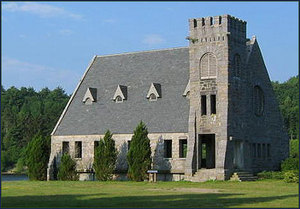In 1897, the Nashua River was dammed by the Wachusett Dam in Clinton, MA, thus starting the beginning stages of the Wachusett Reservoir. The granite dam in Clinton spans 971 feet and rises some 114 feet above the ground. It remains the largest hand-built dam in the world. Located along Route 70 in Clinton, it is indeed an amazing site. The view from the road will show you the top and a view of the 114 feet down. In return for hosting the dam, Clinton was able to secure free water and sewerage.
The reservoir flooded sections of Boylston, Clinton, Sterling, and West Boylston. Particularly hard hit was the small industrial town of West Boylston, a victim of geography and pure water. West Boylston was at the confluence of the Nashua, Stillwater, and Quinapoxet rivers making it attractive to manufacturing and to the Massachusetts government. Desperate for more water resources for the growing city of Boston, some 50 miles to the east, the legislature moved quickly to study potential locations for new water resources. Sites considered included Lake Winnepesauke in New Hampshire, but there were serious political hurdles involved with this and the Merrimack River was heavily polluted by waste.
In all, building Wachusett required removing 360 homes, eight schools, four churches, six large mills, 19 miles of road and more than six miles of railroad tracks. It even required relocating several cemeteries with over four thousand bodies moved to the local Catholic cemetery. The Town on Boylston lost most of its industry, half of its citizens, and more than 2,000 acres of prime farmland to the waters of Wachusett Reservoir,
The reservoir claimed some 4,300 acres or 7 square miles of the local towns. It was finished by 1905 and filled in 1908. When it was built it was the largest body of water in Massachusetts, since made second by the Quabbin Reservoir in Western Massachusetts. What Wachusett did to West Boylston was dwarfed by the complete destruction of the towns of Dana, Enfield, Greenwich, and Prescott. The remaining land was annexed to the towns of Belchertown, Pelham, New Salem, Petersham, Hardwick and Ware.
The Quabbin Reservoir supplies the Wachusett Reservoir, which in turn supplies the Weston Reservoir. This system supplies water to the Massachusetts communities getting water from the “MWRA” or Massachusetts Water Resources Authority.
The most recognizable symbol of the building of the reservoir, is the Old Stone Church in West Boylston. It was a white elephant by the time it was finished, having a life of about ten years before the legislature announced the building of the reservoir in 1895.
Building the reservoir was mechanized only by horses, mules and simple mechanical devices, such as pulleys and levers. Steam was the only source of power. One unintended consequence of the building of the reservoir was the influx of immigrants to the area.
Today, as one drives the area around the reservoir into West Boylston, one will note the absence of antique buildings. Most of the developed town was in the way of the reservoir while farm land remained in the untouched parts of town. In a real way, while the building of the reservoir preserved a natural, rural town in West Boylston, it also ripped the soul out of the town. Today, the reservoir offers fishing as recreation.
